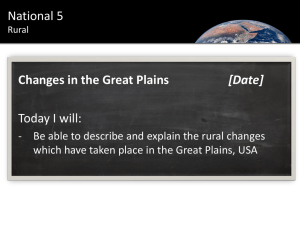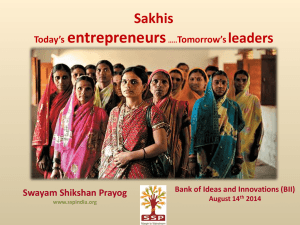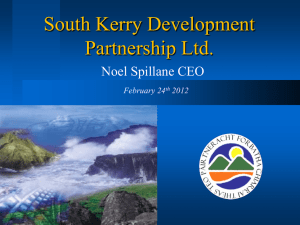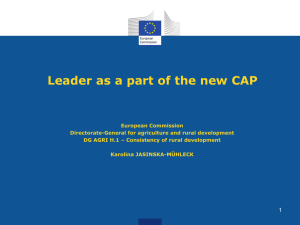National Water Study
advertisement
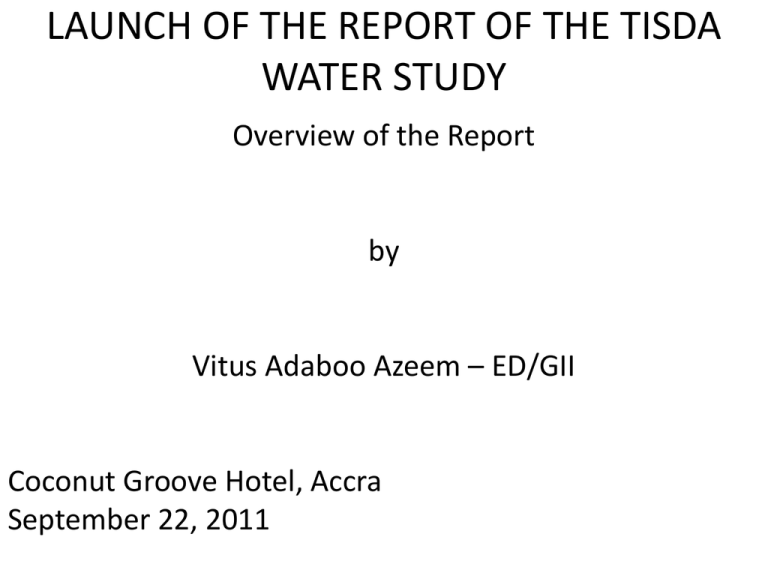
LAUNCH OF THE REPORT OF THE TISDA WATER STUDY Overview of the Report by Vitus Adaboo Azeem – ED/GII Coconut Groove Hotel, Accra September 22, 2011 Outline of Presentation • • • • • • • • • • Introduction of Ghana Integrity Initiative The Research Project Broader Governance Issues Overview of the Water sector Country Data Water Resources Situation Water Sector Governance Rural Water Supply Urban Water Supply Achievements, Challenges, Opportunities & Recommendations Ghana Integrity Initiative • GII was established in 1999 as a non-profit civil empowerment organization with a vision of a corruption-free Ghana • GII is the local chapter of Transparency International (TI), the leading international nongovernmental organization (NGO) devoted solely to the fight against corruption worldwide. • It strives to be the leading anti-corruption organization empowering citizens to demand responsiveness, accountability and transparency from people and institutions in Ghana. The Research Project • Following a decision to focus on improved service delivery through a reduction in corruption TI sought funding to undertake the project • “Transparency & Integrity in Service Delivery in Africa” (TISDA) in a number of African countries focusing on Health, Water and Education. • The project is sponsored by the Bill and Melinda Gates Foundation through Transparency International Secretariat for a three-year period • Participating chapters were allowed to choose the Why GII Chose to focus on Water • • • • • • • Water is a basic necessity and cannot afford to be inaccessible. Quality water positively impacts all other basic necessities of life. If water is priced at an economic rate, the poor turn to low quality sources with negative implications. Low quality water and inadequate sanitation facilities have health implications The poor who already cannot afford quality health care face a double jeopardy Access to water impacts enrolment in school by the girl-child The Water sector is also a national policy focus – GPRS & MDGs The Research/Project Approach • The project aims at identifying risks related to a lack of transparency and integrity and their potential negative impacts on water supply performance. • Comprised two phases: – The Assessment / Survey phase (2009 - 2010) – Advocacy Phase (2011) Sectoral Mapping Exercise • Sector-related expertise available within the national chapter • Sector-related studies and research carried out by others • Sector-related projects/activities carried out by others • List of existing and potential partners with expertise in the sector and/or interest in anti-corruption work • Donors supporting work in the sector • Journalists and other members of the media potentially interested in the programme The First Phase • Identification of key stakeholders in the water sector • Consultative meetings with key stakeholders. • Establishment of a Steering Committee • Preparation of water sector diagnosis • Case studies – Madina & Nima (GAR), Ahoe & Adaklu Aboadi (VR), Bekwai (AR) • Community meetings on the case studies • Validation workshop on National study Rev 1: Broader Governance Issues • The basis of Ghana’s governance is the 1992 Constitution which emphasises – transparency, – integrity, – Accountability; and, – Participation in all spheres of development. • Several Acts & Regulations aimed at ensuring transparency, accountability: – Audit service Act 2000; – Asset Declaration Act 1998; – Public Procurement Act 2003; – Financial Administration Act 2003, – Whistleblower Act 2006; and Rev 2: Broader Governance Issues • The media is the most free in Africa and has been at the forefront in the fight against corruption. • The establishment of state institutions like the CHRAJ, the SFO (EOCO) and Office of Accountability (Research Unit at the Castle) seek to curb corruption • The formation of Ghana Integrity Initiative and the Ghana Anti-corruption Coalition (public, private and Civil Society Organizations) to focus on the fight against corruption • However, the general perception is that corruption is prevalent and a serious problem in the country. The Current Situation - Urban • Most urban communities have access to pipe-borne water. • However, some of these communities, even in Accra, do not have access to water delivery • Even those who have access to water delivery, it is irregular and unsatisfactory • Yet, water tariffs are relatively high and unaffordable by poor urban communities • Illegal connections to the systems and inability to collect water tariffs compound the problems of urban water supply. The Current Situation - Urban • Sanitation in the cities has become a major problem due to lack of proper planning and enforcement of building regulations • Natural water bodies and choked gutters breed mosquitoes, resulting in high rates of malaria • Women and children are the worse affected. The Current Situation - Rural • Rural communities depend on water from natural sources such as rivers, streams, etc. as well as wells and boreholes. • Rural communities, unlike the urban communities, are required to contribute to the cost of the systems and maintain them. • Rural water sources are more reliable, especially when the rains are regular but are less hygienic. The Current Situation - Rural • Some of the water sources have problems of taste, high levels of flouride, etc. • In the rural communities, there is virtually no sanitation facilities or limited facilities • Malaria is a problem in the rural areas due to ignorance of, and non-adherence to, hygienic practices & poverty. • Guinea worm (a water-borne disease) is also prevalent in some rural communities, requiring serious attention to avoid infection. Country Data Indicator Value •Total Land size •Pop. Density 238,533km2 Average 79.3 •Total Pop. 2005 •Total Pop. 2015 (Projection) •Pop. Growth 2005-2015 21.4 million (Urban 46%, rural 54%) 28.1 million (Urban 49.6%, rural 50.4%) Urban 4.6%, rural 1.5% •No. of Settlement (2000) Urban 366; rural 88,290 (below 5000 pop) •GDP (PPP) (USD/capita) 2009 USD 1452 (country ranking: 140) •% below poverty line (2005/6) •% below extreme poverty line Gen. 28.5%; urban 10.8%, rural 39.2% Gen. 18.2%; urban 5.7% , rural 25.6% •Level of poverty (USD/capita)2005/6 •Level of extreme poverty (2005/6) USD433, urban USD 563, rural USD 332 USD 314 •Water supply coverage, 2007 •Sanitation coverage, 2007 Urban 59%, rural 53% Urban 40%, rural 32% Country Data Contd Indicator Value Under five mortality, 2006 Gen. 111, urban 106, rural 114 Corruption Perception Index (2008/9) 3.9 (ranking 67th out of 180 countries) Human Development Index 2008 Index: 0.533; (ranking 135th out of 177 countries) National Investment in the water sector 2004 – 118 billion cedis (USD 13.1 million) 2006 – 882 billion cedis (USD 95.9 million) 2007 – 1144 billion cedis (USD 117.9 million ) Sources: GSS 2005, 2007; Multiple Indicator Cluster Survey, 2006,; UNDP 2008 GII 2008 Exchange rate 1USD = 9000 cedis(2004), 9200 cedis (2006), 9700 cedis (2007) Water Resources Situation Indicator Value Renewable water resources 2637m3/capita (2002) Water Scarcity Level Well below the water scarcity level, but locally water scarcity may occur Trend in Water scarcity situation Water availability is reducing Regional Variation Regional variation in water scarcity is considerable Water distribution (2000 Agriculture 655 million m3 (66%) Industry 98 million m3 (10%) Domestic use - 235 million m3 (24%) Proj. Dmd for consumptive water (2020) Proj. Dmd for hydropower generation 5 billion (12% of surface water) 378,430m3 (22% of surface water) Trans-boundary basins and related countries Volta Basin – Ghana, Togo, Burkina Faso, Ivory Coast, Benin Bia Basin - Ghana and Ivory coast Water Resources Situation • Domestic and industrial urban supplies are based on surface water (Some with quality problems due to mining activities). • In rural areas, groundwater is used in hand pump schemes (200,000 boreholes and hand dug wells country wide). • Rainwater harvesting is becoming more common • The main non-consumptive uses are hydropower generation, inland fisheries and water navigation Overview of the Water Sector Indicator Value Access to improved water supply systems Overall 80%; urban 59%; rural 53% (2006) % increase over previous five years (2000- Overall 1.85%; urban 0.38%; rural 3.38% 2006) MDG water (2015) Overall 78%; urban 91%; rural 69.5% Regional Differences Strong regional variations in access to improved water exist ranging between 53% in Volta region and 95% in upper West region Differences in access in water between rich and poor (MICS 2006) On the average, 64% of poorest households have access to improved water supply against 96% of the richest. Cont’d Indicator Value •Access to improved sanitation (2006) •% increase over previous 5 years 20002006 •Overall 60.7%; urban 82.6%; rural 45.3% •Overall 60.7%; urban 1.18%; rural 3.33% •MDG Sanitation (2015) Overall 53%; urban 55.5%; rural 51.5% •Progress with MDG’s in water and sanitation •Meeting MDG’s for water and sanitation may be feasible, but progress may be limited by lack of resources and cost involved in sustaining systems. Rural sanitation coverage is lagging behind. •Regional Differences •Significant differences exist between regions with average coverage ranging from 17% to 87% with lowest coverage in the three northern regions Sources: MICS 2006, JMP 2009, CWSA SIP 2008, TREND/TPP, 2008 Cont’d Item Definition Access to improved urban water supply 12 hours of access to between 75 and 100 liters per capita per day Access to improved rural water supply Access to between 20 and 60 liters of water from pipe scheme, borehole fitted with pump, hand dug well fitted with pump, protected spring for between 50-70% of the time with a lag between breakdown and repair not exceeding two weeks and within a distance of not more than 500 meters or within 15 min of walking distance. Cont’d Access to improved urban sanitation Access to improved rural sanitation Source: JMP (2008) Access to improved toilet facility within a house or from a shared facility Access to adequate excreta disposal facilities-VIP at household, a simple but protected pit latrine, a pour flush latrine, KVIP, Aqua Privy or connected to a septic tank system Water Policies • National Water Policy (2008) • Aims at sustainable development of water resources. • Stresses the coordination between sector institutions and encourages private sector participation in the management of water systems. • Anti corruption policies • There are no special anti-corruption policies for the WASH sector - same as those that apply for other sectors in the country Sector Legislations Specific acts and legislations related to water and sanitation: • Article 269 of the 1992 constitution, Local Government Act, 1993, The Statutory Corporations (Conversions to Company) Act 1993 (Act 461), PURC Act, 1997, CWSA Act, 1998, WRC Act (1996), Water Use Regulation (2001), Standard for Drinking Water Supply (1998) - GSB. • The existing legislations as well as institutional responsibilities need to be reviewed for possible gaps and performance problems of the different organizations. • This requires strong political commitment as it is clearly necessary. For example, sanctions and rewards are missing Sector Regulation Item Weakness identified Tariff Formal tariff setting is only established independently for part of urban water supply systems owned by GWCL. Poorer sections end up paying more per liter because they buy water from vendors at higher price. Access Equal access is established in the law, but in practice is not the case, with the poorer sections having less access Quality Quality guidelines are existing but not monitored and not been adhered to in piped water supply but also in sachet and bottled water Water sector Financing Funding Source Purpose • 2004 2006 2007 Million USD % Million (USD % % Million (USD) National Funding Rural WS Urban WS Sub total 1.68 1.45 3.13 8.0 6.8 14.8 2.38 1.70 4.08 2.5 1.8 4.3 3.36 2.06 5.42 2.9 1.8 4.7 International Funding Rural WS Urban WS Sub total 13.46 4.52 17.98 63.8 21.4 85.2 58.14 34.15 92.29 60.3 35.4 95.7 60.27 4.94 10.99 52.5 42.8 95.3 21.11 100% 96.37 100% 114.91 100 Overall Total Source: MOFEP 2004, 2006, 2007 budgets Water Sector Financing • Water sector financing depends on three main pillars; Donors (90%), Payment of tariffs by users, modest contribution from government . • Grant funding from donors are managed by PMU financed by the donors who work closely with RWSTs and MMDA’s in project management, contract management. • National funding for water service delivery by MMDA’s are obtained from DACF and IGF. • The contribution of NGO’s is largely unknown because it is not captured in the budgeting process at national or local level. Affordability, cost recovery, cost sharing • Urban supplies: Tariffs paid by users are used: – to recover cost, – to meet operations & maintenance cost – For repayment of investment cost. • Tariff structure is based on progressive pricing, allowing cross-subsidies from large users. GHC 0.66/ M3 (lifeline tariff) GHC0.91 M3 (excess 20M3) GHC1.10 (commercial tariff) making the poor pay higher price Affordability, cost recovery, cost sharing • Rural Supplies: Tariffs paid by users are used to meet O&M cost , major repairs, replacement and extension to new areas. • 90% of construction cost is subsidized • 5% contribution each by community and MMDA’s towards capital cost of water supply systems • Tariffs Domestic rate: GHC 1.65 /M3 Commercial rate: GHC 1.85 /M3 • Estimate of family expenditure on rural/small town system range b/n USD 0.94 – USD 2.76 • 90% of households pay for water through pay as you fetch or monthly fees Funding Requirement • An amount USD 1.49 billion would be required for expansion of water supply to meet demand to 2020 (Sector Development Program – 2009). • An amount of USD 811 million would be required to meet the MDG on water in 2015. • Average inflow of resources forms 35% of the level that would be required annually. • Total financial investment needed to achieve MDG for rural water is USD 505 million. • Donor pledge from 2008-2012 (USD 175 million) leaving a gap of USD 330 million for the RWS. Water Sector Governance • Transparency – Measures for ensuring transparency in the sector are established which include • Regular reporting systems (financial reporting/project activities), • Regular meetings , • Regular auditing of accounts and publications and documentation of the tendering process. However, compliance is weak. • Accountability - Accountability efforts have been upwards through routine submission of monthly, quarterly, annual, project completion and financial reports required by law and project agreements. However, processes for ensuring downward accountability is very low. Water Sector Governance • User participation: • This is a central theme in NWP but is very low. • Users do not participate in decision making and meetings are not held with users. • Gender issues have duly been acknowledged in the sector including the participation of women in decision making. In the formation of watsan committees, at least 3 members (7) of the watsan committees are females. Water Sector Governance - Grand Corruption • Single contractor buying and pricing all bidding documents, • Award of a number of contracts to the same contactor under different names, • Procuring entities making payment before due dates; • Advancing funds for mobilization beyond the 15% allowable limit, • Over- invoicing, poor contract management, • Poor training and working conditions of construction workers and • Shoddy work through the use of poor quality materials. Water Sector Governance – Petty Corruption • • • • • Illegal connections, Meter tampering, Direct payment to meter readers and Under reporting of daily sales by vendors Illegal charges and/or over-invoicing of materials for new connection Rural Water Supply Indicators Assessment Coverage Rural water supply coverage is estimated at 69% in 2006. (17,280 boreholes, 4,236 hand dug wells, 185 piped schemes). Considerable difference exist ranging from 52.7% in the Volta region to 94.8% in the Upper West region. Quantity The water quantities used seem to be on the low side and below the standards that CWSA uses. Actual consumption are 8-10 liters for hand pumps and 8-15 for small town systems (TREND /TPP – 2008). NRW varies with systems (50% level found) Legal Situation WATSANS and WSDB are semi autonomous voluntary community members acting on behalf of the MMDA’s who are the legal owners of the systems. WATSANS and WSDB are recognized by MMDA’s but not legally established entities so they cannot be legally prosecuted or controlled. Rural Water Supply Continuity Considerable waiting lines may occur at hand pumps at peak hours and breakdown periods may take 3-4 weeks. Small piped schemes with public stand posts usually operate 12 hours. In the wet season usage of hand pumps and small piped schemes is lower as people revert to cheaper sources such as rain water harvesting Quality Water quality standards are not implemented. Most systems depend on relatively good quality ground water. Yet 20% of drilled wells have iron and manganese problems and some face salt water intrusion. Cost &Efficiency Construction cost are paid by donors or the government with 5% each contribution of the community and the MMDA. Running cost are paid by users through user charges. Small town systems may cost USD 0.60 per M3 Integrity Analysis Indicator NCWSP Service provision Transparency •Information is Reporting to users available about is less well procedures and established. shared among different actors. •Reporting to users is less well established. •Lack of information about unit cost of services, sector standards and quality measures Cont’d (Integrity Analysis) Accountability Technical and financial audits are being implemented. The application procedures and sanctions are weak (due to challenges), inadequate monitoring of procurement and selective bidding Technical and financial audits are not implemented. Complaints are dealt with the watsan committees or WSDB Cont’d (Integrity Analysis) Anti corruption Participation of users Control mechanisms are in place as clear procedures are included in the project implementation manual Control mechanisms are in place. Users are consulted in the process and need to take action as a demand responsive approach is applied. Users/CSO’S are not involved in the procurement process. Public do not participate in decision making.; Involvement of public in tariff setting is yet to be fully realized. Staff are requested to sign a code of conduct User Perception • Some interference from politicians and traditional leaders in decision making in the Watsan and WSDB. • Revenue collectors may not deposit all the money they receive. • Powerful board members can illegally borrow money from the account and even forget to repay. • Vendors at stand posts without meters can under report sales • Remote communities are susceptible to cheating - a spare part could not be procured from a regional distributor but only the Zonal center which involves significant transport cost Urban Water Supply Coverage (MICS 73% of the urban population have access to pipe borne water of 2006) which 43% obtain water outside the house; 15% have access to water from wells, 22.5% have access to natural sources; 8.4% have access to tanker services; water vendor (3.4% ) and sachet/bottled (4%). Only 15% of the poor have direct access to piped water Quantity Continuity Design standards use 75-150 liters while actual consumption is 5060 liters. Poorer sections of the community have a much lower consumption level. GWCL current average output is 551,000m3/ per day as against daily demand of 939,000/ M3 Most of the design systems are over 30 years old and cannot cope with increase in water demand. Water is rationed to many consumers. Some (25%) have 24 hours supply, (30%) have 12 hours, five days a week, (35%) have water 2 days each week or less; (10%) are without access to piped water Urban Water Supply Quality Water quality is questionable as most of the supply is intermittent and drainage problems are visible in many areas which may cause contamination. Although PURC has issued some guidelines for tankers, in practice the quality of water from tankers is not being monitored. Cost and Efficiency AVRL makes an operation surplus which is handed over to GWCL. The cost is GHC0.66. In 2001, the connected poor used 35 liters per capita whilst those depending on other suppliers used 15 liters NRW = 51.5% Legal Situation GWCL’s management contract with AVRL has been terminated. Majority of secondary providers are not strictly regulated. Source: GLSS (2008), PURC (2001), JMP (2009), Nyarko et al (2007), TPP/TREND (2008) NWP (2008 Integrity Analysis Indicator GWCL (Water service Development) GWCL (Service provision Transparency •Information is available about procurement procedures & international tendering is a condition of ESA. •Reporting to users is less established. •Getting a connection is cumbersome giving room for corruption Information is available about the performance of AVRL through its annual report to GWCL. Information on tariff are published and available in AVRL offices Reporting to users is less established Integrity Analysis Accountability •Technical and financial audits are being implemented. •The MWRWH has established procurement evaluation unit but have staff limitations •Application of sanctions & procedures are weak; Inadequate monitoring of procurement and selective bidding. Technical and financial audits are being implemented and include audits by GWCL and PURC. AVRL has a consumer service which handles complaint PURC has a complaint section and routinely organizes interactions with consumers Integrity Analysis Anti corruption Control mechanisms are in place and clear procedures are included in the conditions that ESA apply for providing loans. Staff are requested to sign a code of conduct and transparency rules and regulations apply to different actors •Control mechanisms are in place and clear procedures are included in the management agreement b/n GWCL &AVRL •Staff are requested to sign a code of conduct and transparency rules and regulations apply to different actors. Participation Public can only participate through its public rep.; GWCL has a code for public hearings but not strictly applied; Users/CSO’s not involved in decision making. Public can only participate through its public rep.; Involvement of public in tariff setting is yet to be fully realized. Achievements • The research /risk mapping phase has been completed and the report is being printed. • Due to the delay in the advocacy phase not much progress has been made so far with regards to real change • However, informal influence and awareness raising through various stakeholder meetings and feedback in the community have been achieved • Partnerships and working relationships established • A non-functional borehole in Adaklu Abuadi Achievements • Publication of reports by water committees for community members • Organization of regular meetings by water committees for users to enable them participate in decision making • Publication of price list of spare parts and charges by area mechanics for water committee to ensure accountability • Proper record-keeping, including obtaining receipts for spare parts purchased by area mechanic Challenges • Difficulty in accessing relevant data due to unavailable records or reluctance to provide information needed. • Suspicion of GII’s intention by some stakeholders • Most anti-corruption work has taken place on national level and not at the local level. • Inadequate networking and advocacy on corruption in service delivery • Inadequate information and data on what happens at the decentralised level, which sets new challenges for addressing corruption and improving transparency and accountability in the sector. Opportunities • Establishment of fair wages commission and single spine pay structure may lead to payment of realistic salaries and living wages • Since 2003, a number of laws have been enacted to strengthen transparency and accountability although many of them are not enforced; • Anti-corruption institutions and CSOs educating the public to eschew greed and be loyal to the state • Some attempt at introducing policies such as LEAP to address poverty and improve the living conditions of people. Recommendations • There is the need to streamline and strengthen anticorruption tools and the capacity of sector agencies to implement these tools. • There is also the need for donors to introduce anticorruption clauses in all cooperation agreements, train their own staff or local staff to put these policies into practice and communicate on related activities and progress made, • Donors too should adhere to the highest standards of information disclosure and consultation for all water projects they support, put in place adequate monitoring mechanisms and enforce effective sanctions against corrupt employees and contractors. Recommendations • There is the need to create anti corruption awareness and systems within public organizations so that they can cooperate with civil society effectively to ensure that corruption can be prevented from occurring or dealt with adequately when it occurs. • There is also the need to institutionalize the involvement of a representative of civil society at each of the levels of public procurement. • There is the need to increase access to information to the public on the operations of the utility providers by publicizing utility accounts, public expenditure reviews and audit information, budgets, contracting arrangements and annual report. Recommendations • Involving users in decision making, tariff setting etc. to ensure that beneficiaries are empowered to play a meaningful role in the management of water resources, from the design to the implementation and supervision of WRM projects. • Strengthen complaint mechanisms for users and provide adequate whistle blowing protection to promote meaningful citizen participation. • There is the need to strengthen monitoring and oversight mechanisms such as oversight committees, ombudsman offices, complaint offices, etc. CONCLUSION • Lack of transparency and integrity in aid promotes corruption, which poses a threat and has devastating consequences on poverty reduction and development. • With regards to water supply, corruption increases the risks that resources are lost thus affecting adequate access of basic services to the poor. • Thus, there is a need to strengthen accountability mechanisms and institutions of oversight and the sanctioning of violators to ensure clean infrastructure projects and water delivery. Appreciation • Thank You for your attention

